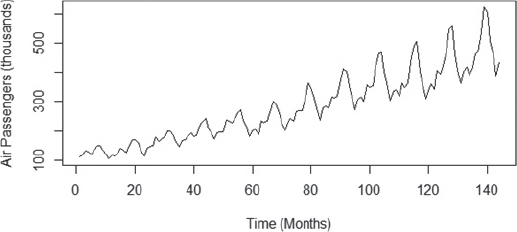8
Advanced Analytical Theory and Methods: Time Series Analysis
Key Concepts
ACF
ARIMA
Autoregressive
Moving average
PACF
Stationary
Time series
This chapter examines the topic of time series analysis and its applications. Emphasis is placed on identifying the underlying structure of the time series and fitting an appropriate Autoregressive Integrated Moving Average (ARIMA) model.
8.1 Overview of Time Series Analysis
Time series analysis attempts to model the underlying structure of observations taken over time. A time series, denoted Y= a+bX, is an ordered sequence of equally spaced values over time. For example, Figure 8-1 provides a plot of the monthly number of international airline passengers over a 12-year period.

FIGURE 8-1 Monthly international airline passengers
In this example, the time series consists of an ordered sequence of 144 values. The analyses presented in this chapter are limited to equally spaced time series of one variable. Following are the goals of time series analysis:
- Identify and model the structure of the time series.
- Forecast future values in the time series.
Time series analysis has many applications in finance, economics, biology, engineering, retail, and manufacturing. Here are a few specific use cases:
- Retail sales: For various product lines, a clothing retailer is looking to forecast future monthly sales. These forecasts need to account for ...
Get Data Science and Big Data Analytics: Discovering, Analyzing, Visualizing and Presenting Data now with the O’Reilly learning platform.
O’Reilly members experience books, live events, courses curated by job role, and more from O’Reilly and nearly 200 top publishers.

